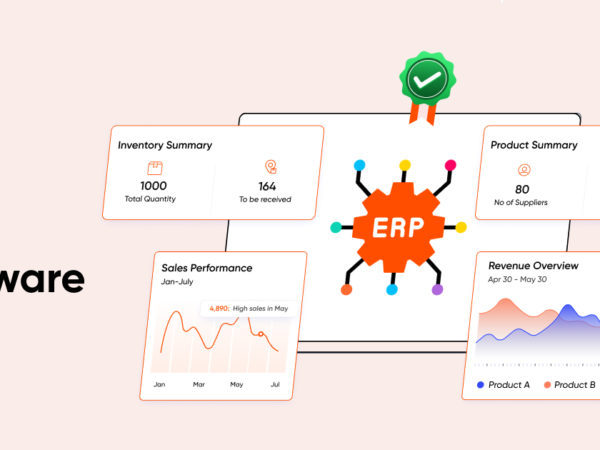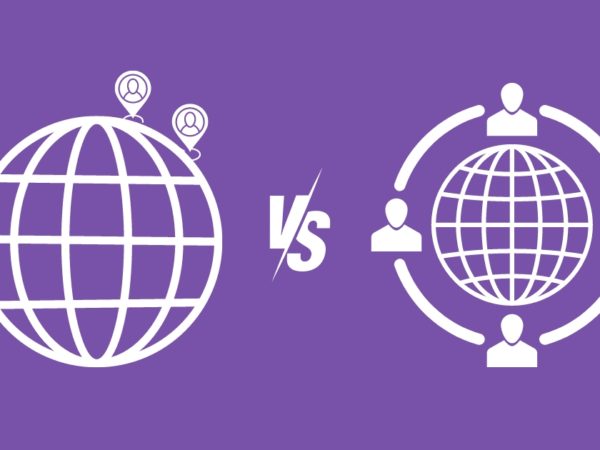<img alt="Intellectual Property" data- data-src="https://kirelos.com/wp-content/uploads/2023/09/echo/Intellectual-Property.jpg/w=800" data- decoding="async" height="420" src="data:image/svg xml,” width=”800″>
Does your business or agency often handle creative content like images, GIFs, multimedia, taglines, marketing copies, product copies, product graphics, and more? You must learn what intellectual property is to protect such invaluable digital content from piracy!
At the heart of digital marketing and digital businesses, there are professionals who constantly share digital creative content within the company or with external vendors.
Whether it’s a captivating social media campaign, an engaging website, or innovative multimedia content, exchanging such digital assets is the lifeblood of the online ecosystem.
You’re sharing your website code with a freelance developer or onboarding a contractor to post articles through your website CMS using your brand assets like images, logos, and so on. How can you do this without worrying about piracy?
Here comes intellectual property and the legal rights that protect your creative and intelligent content in this scenario.
Read this article till the end as I explain this highly technical concept in easy language. Therefore, you can digest it quickly, make changes in your digital agency or business, and make yourself IPR compliant!
What Is Intellectual Property?
<img alt="YouTube video" data-pin-nopin="true" data-src="https://kirelos.com/wp-content/uploads/2023/09/echo/maxresdefault.jpg65044559cfac7.jpg" height="720" nopin="nopin" src="data:image/svg xml,” width=”1280″>
Intellectual Property (IP) is like a shield for your creative stuff. It covers things you make in your head, like inventions, art, music, and even business ideas. It says, “This is yours, not anyone else’s.”
IP includes copyrights for art and music, patents for inventions, trademarks for logos, and trade secrets for business strategies.
Employees and contractors working in your business and creating such stuff are also protected by IPR, and the assets belong to you since you pay for those in the form of salaries or hourly payments.
For example, you host a personal hobby blog online. You commissioned a writer to write an article for you against a fixed payment. You also published the article on your blog, giving the writer a byline.
Now, the writer chooses to copy and paste the same content and post it from their own blog or Medium, WordPress, etc., sites. This is an intellectual property rights infringement by the writer.
They can promote the content by linking it to the originally published site, which is yours, but they aren’t allowed to publish the article as is or as a summary on other portals without crediting your website.
International IP Treaties and Agreements
The following are some of the locally and globally effective treaties that respect your intellectual property rights over your intangible digital creations:
#1. TRIPS Agreement
The World Trade Organization (WTO) administers the Agreement on Trade-Related Aspects of Intellectual Property Rights (TRIPS). It sets minimum standards for IP protection among member countries.
#2. Paris Convention
The Paris Convention is an IPR treaty that deals with the protection of industrial property, including patents, trademarks, and industrial designs.
#3. Berne Convention
The Berne Convention is an international copyright treaty. It establishes minimum standards for copyright protection among its member countries.
#4. Patent Cooperation Treaty (PCT)
PCT makes the process of internationally seeking patent protection simple by allowing a single international patent application.
#5. Madrid Protocol
The Madrid Protocol is an agreement that simplifies the international registration of trademarks by allowing a single application to cover multiple countries.
#6. Hague Agreement
The Hague Agreement enables the registration of industrial and business designs internationally. Thus, if you brainstorm, develop, and register an industrial design in the USA under the Hague Agreement, then it’ll be equally protected by IPR laws in member countries worldwide.
#7. Budapest Treaty
The Budapest Treaty relates to the international recognition of the deposit of microorganisms with the intent of patent procedures.
#8. WPPT
WIPO Performances and Phonograms Treaty protects the rights of phonogram performers and producers in the digital environment.
#9. WCT
WIPO Copyright Treaty is an extension of the Berne Convention. It addresses digital copyright issues.
#10. Nairobi Treaty
The Nairobi Treaty provides protection to the Olympic Symbol so that no party can use the symbol for commercial or personal purposes without getting written consent from the International Olympic Committee.
Types of Intellectual Property
Copyright
<img alt="YouTube video" data-pin-nopin="true" data-src="https://kirelos.com/wp-content/uploads/2023/09/echo/maxresdefault.jpg6504455a2b2ac.jpg" height="720" nopin="nopin" src="data:image/svg xml,” width=”1280″>
Copyright is one of the most common types of IP that offers legal protection to original creators of a tangible or intangible work. It covers things like books, music, artwork, and similar things.
With copyright, you can ensure that others can not copy or share your creations without your explicit permission. Besides encouraging the creativity of the content creators and rewarding them for their efforts, it allows them to benefit from their work for a certain period.
Trademark
<img alt="YouTube video" data-pin-nopin="true" data-src="https://kirelos.com/wp-content/uploads/2023/09/echo/maxresdefault.jpg6504455a3a344.jpg" height="720" nopin="nopin" src="data:image/svg xml,” width=”1280″>
A registered trademark is a type of IP that can distinguish a product or service from others. You can trademark a word, phrase, design, or symbol with a recognizable badge to help people identify your products.
When a business registers a trademark, it gets exclusive rights to use that mark for its unique work. At the same time, it prevents others from using the exact same thing or something similar to maintain your brand integrity.
Patent
<img alt="YouTube video" data-pin-nopin="true" data-src="https://kirelos.com/wp-content/uploads/2023/09/echo/maxresdefault.jpg6504455a48a6d.jpg" height="720" nopin="nopin" src="data:image/svg xml,” width=”1280″>
Getting a patent is the most efficient way for inventors to protect their inventions. With it, inventors get the sole right to control the manufacturing, usage, and distribution of their work.
Usually, the validity of a US patent lasts for 14 to 20 years from the date of filing for the patent. A patent offers an exclusive right that encourages innovation in fields like technology, healthcare, and medicine.
Trade Secret
<img alt="YouTube video" data-pin-nopin="true" data-src="https://kirelos.com/wp-content/uploads/2023/09/echo/maxresdefault.jpg6504455a580ae.jpg" height="720" nopin="nopin" src="data:image/svg xml,” width=”1280″>
A trade secret refers to the confidential information held by an individual or business that offers them an edge over the competitors. A trade secret could be formulas, recipes, strategies, or even a list of customer lists that has to stay secret for as long as you want it to be.
Industrial Design Right
<img alt="YouTube video" data-pin-nopin="true" data-src="https://kirelos.com/wp-content/uploads/2023/09/echo/maxresdefault.jpg6504455a65006.jpg" height="720" nopin="nopin" src="data:image/svg xml,” width=”1280″>
An industrial design right is used to protect the visual appearance of a product from unauthorized usage. It secures elements like the shape or aesthetic design of something. It allows creators and businesses to fairly compete with others while benefitting from their efforts by preventing others from imitating the unique look of a product.
Utility Model
<img alt="YouTube video" data-pin-nopin="true" data-src="https://kirelos.com/wp-content/uploads/2023/09/echo/maxresdefault.jpg6504455a7bb44.jpg" height="720" nopin="nopin" src="data:image/svg xml,” width=”1280″>
Similar to patents, this type of intellectual property grants protection to useful inventions. However, It provides inventors with exclusive rights for a specific period shorter than patents. These IP is suitable for incremental inventions and for inventions with a shorter lifespan.
Semiconductor Topography
Semiconductor topography is a special type of IP that protects the layout or design of various components and their connections within these electronic devices. With this, innovations in the electronics industry are safeguarded from unauthorized copying or reproduction, and the original creators and designers are benefitted.
Database Right
Using the database right, you can legally protect the exclusive right to control how the database is used. It also stops other companies from extracting or reusing database components without permission. Database right encourages database developers to invest time and effort into compiling information into the databases.
Why Is Intellectual Property Important for Businesses?
- IP safeguards your company’s unique ideas, inventions, and creations from being copied or used by competitors.
- It can enhance a business’s value, making it more attractive to investors and potential buyers. The more patents and IPs your business gets, the higher valuation you can get.
- Intellectual property provides a competitive edge by allowing your business to offer unique products or services that your competitors can’t replicate.
- You can monetize your IP rights over certain assets and get extra revenue from the market.
- When businesses respect IP laws and treaties around the globe, creative thinkers and creators feel safe to create more invaluable assets for those businesses.
- Your trademarks and trade secrets build strong brand identities for your product or services. This, in turn, fosters customer trust and loyalty.
- If your competitor still replicates your intellectual property, you can present your patents, copyrights, trademarks, etc., as legal proof to sue the competitor.
- You can easily market your intelligent creations in the international market without fear of intellectual property piracy because there are international treaties for IPR.
- Intellectual property rights (IPR) help businesses secure their position and relevance in the market over the long term.
- Intellectual property protection encourages collaboration and partnerships, as businesses can share their IP under specific agreements.
Let’s explore some common intellectual property examples.
Common Intellectual Property Examples
Find below the top intellectual property examples around the world in various important domains of business:
- The distinctive LV monogram pattern on Louis Vuitton products is a registered trademark IP.
- Starbucks’ green mermaid logo is a trademark that distinguishes its coffee shops, coffee cups, and other assets on which this monogram is labeled.
- Nike’s Air Jordan Logo, or the Jumpman logo associated with the Air Jordan line of sneakers, is a trademark owned by Nike.
- Characters like Mickey Mouse and Cinderella are protected by both copyright and trademark, ensuring Disney’s exclusive rights.
- The code and software design of Microsoft Windows operating systems are copyrighted to prevent unauthorized distribution.
- The blend of herbs and spices used in KFC’s fried chicken is a well-protected trade secret.
- Google’s search algorithm is a closely guarded trade secret, giving it a competitive edge in the search engine market.
- Apple holds design patents for the distinctive look of their iPhones, preventing others from copying their appearance.
- The iconic script and design of the Coca-Cola logo are trademarked to protect the brand identity.
Next, we will discuss what intellectual property infringement is.
What Is Intellectual Property Infringement?
<img alt="YouTube video" data-pin-nopin="true" data-src="https://kirelos.com/wp-content/uploads/2023/09/echo/maxresdefault.jpg6504455aa57d6.jpg" height="720" nopin="nopin" src="data:image/svg xml,” width=”1280″>
When someone violates IPR laws like trademarks, copyrights, patents, etc., and creates tangible or intangible products for commercial or personal use, that’s intellectual property infringement.
It’s like taking your ideas, inventions, or art and using them as if they’re theirs. This can happen with things like copying a book, using a logo without permission, or selling a patented product without the owner’s consent.
IPR infringement is against the law because it hurts the creators and owners of these things. It’s important to respect other people’s Intellectual Property and ask for permission or follow the rules if you want to use it. Original creative ideas or asset owners have the right to protect their work, and when you infringe on those rights, you can get in trouble.
How to Avoid Intellectual Property Infringement
Here are some ways for intellectual property protection to avoid IPR infringement:
- Perform thorough research to ensure you’re not using someone else’s copyrighted material. For example, when you copy any image from Google Search to post on your blog, that’s IPR infringement unless you obtain written permission from the creator.
- Stay updated on IP laws and regulations to ensure compliance with changing rules.
- Seek legal advice or consult IP experts to navigate complex IP issues and protect your interests.
- Register your digital and creative assets using trademarks, copyrights, patents, database rights, etc.
- License digital assets from their owners if you need to use those for commercial purposes. If you wish to avoid this, you can create digital assets on your own using apps like the following:
- Canva for images, designs, image resizing, logo making, and more.
- Miro to create diagrams, wireframes, whiteboards, process maps, Business Process Modeling, and so on.
- Creately lets you create organizational charts, flowcharts, wireframes, etc.
- Use EdrawMax for floor plan design, diagramming, electrical design, software design, etc.
Next, we will discuss what IPR rights are.
What Is Intellectual Property Rights (IPR)?
Intellectual Property Rights are legal protections that give you, as a creator and inventor, exclusive ownership and control over your intangible creations. These could be codebases, databases, datasets, digital inventions, art, music, and brand identities.
Various IPRs allow you and your digital businesses to prevent others from using, imitating, or profiting from your intellectual property without written consent or a paid license. IP rights include copyrights for creative works, patents for inventions, trademarks for brand recognition, trade secrets for confidential information, and more.
Conclusion
So far, you’ve gone through the intellectual property definition, types, and examples. You also explored intellectual property rights (IPR), various international treaties that safeguard your creations from piracy, and how to avoid IPR infringement. Not to mention, you also learned how to enforce intellectual property protection.
Next, check out how to patent an idea.



